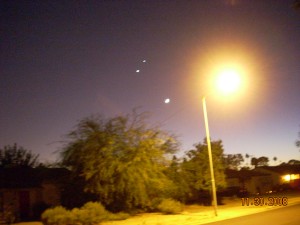Karen, Mare the Bare and our neighbors Chuck, Deb, Daniel and Henry came over to look at the Moon, Venus and Jupiter during the conjunction. Through my astro binoculars we could clearly see 3 of the 4 Galilean moons even with a bright street lamp directly across the street. We also observed the Crescent Moon. The south pole of moon was brilliantly lit affording an incredible view of the mountain ranges and craters. The “star” of the night was clearly seeing Boussingault Crater and the smaller crater inside as well as the central mountain peak created from the impact 3 1/2 billion years ago.
Unfortunately you couldn’t see the phase of Venus because of the city lights and haze. Venus looked like a round fuzzy ball. The best part of tracking the phases, just like the moon, is this helps explain how Galileo figured out that the earth was not center of the solar system, and therefore not the center of the universe. The moon has phases because it obviously orbits the earth. Venus has phases just the same, but it orbits the sun. Through his telescope, Galileo could record the phases of Venus and realized the the crescents were always created by the sun being on the sunlit side. Modeling this information on paper with the day and night of earth, he realized that the earth has phases just like any other planet in orbit around the sun if you could view the earth from space. Although he couldn’t see phases on Mercury, too close to the sun and therefore washed out, he understood the nature of orbital rotation, now called Orbital Mechanics. Unfortunatley for Galileo, the catholic church was not ready to admit that the earth wasn’t the center of the universe and forced him to recant, and then kept him under house arrest for the rest of his life.
bob
